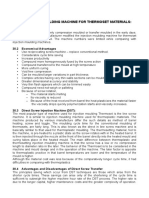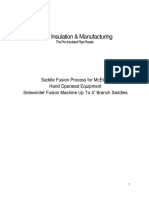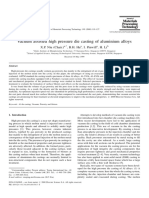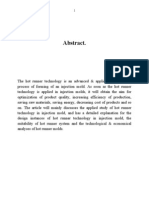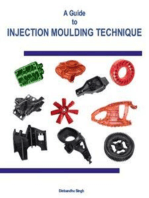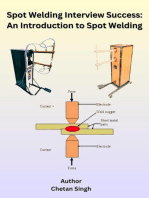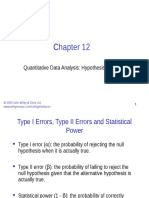0 ratings0% found this document useful (0 votes)
75 viewsExtrusion Welding of Thermoplastics Introduction
Extrusion Welding of Thermoplastics Introduction
Uploaded by
Mehmet SoysalJob Knowledge 57
Copyright:
© All Rights Reserved
Available Formats
Download as PDF, TXT or read online from Scribd
Extrusion Welding of Thermoplastics Introduction
Extrusion Welding of Thermoplastics Introduction
Uploaded by
Mehmet Soysal0 ratings0% found this document useful (0 votes)
75 views4 pagesJob Knowledge 57
Original Title
Job Knowledge 57
Copyright
© © All Rights Reserved
Available Formats
PDF, TXT or read online from Scribd
Share this document
Did you find this document useful?
Is this content inappropriate?
Job Knowledge 57
Copyright:
© All Rights Reserved
Available Formats
Download as PDF, TXT or read online from Scribd
Download as pdf or txt
0 ratings0% found this document useful (0 votes)
75 views4 pagesExtrusion Welding of Thermoplastics Introduction
Extrusion Welding of Thermoplastics Introduction
Uploaded by
Mehmet SoysalJob Knowledge 57
Copyright:
© All Rights Reserved
Available Formats
Download as PDF, TXT or read online from Scribd
Download as pdf or txt
You are on page 1of 4
Job knowledge 57:
Welding processes Others
Extrusion welding of Thermoplastics Introduction
Extrusion welding is used in the manufacture of thick-
section fabrications, such as tanks and pipes, where it
is necessary to produce large volume, homogeneous
seams in a single pass, unlike hot gas welding where it
would be necessary to produce a seam using multiple
runs.
In tank fabrications, the main use of extrusion welding
is to weld the bases and tops, although in certain
applications, the body panels are also welded using this
technique. In large section pipe fabrications, it can be
used where manual welding techniques are required.
Another use for extrusion welding is in environmental
applications where it is used in the joining of lining
material for the construction of landfill waste sites,
lagoons and roof coverings. It is also becoming
increasingly used in agriculture and water engineering,
for example, in the fabrication of land drainage
systems, sump tanks and manways.
Equipment
Extrusion welders are available in a variety of sizes,
from compact units with an integral air supply, weighing a mere 2.8 kg, through
to large 13kg machines used for welding lining material in landfill applications.
They can be supplied in both 110v and 240v configurations.
Fig.1. Extrusion welding gun
Polypropylene tank
made using extrusion
and hot gas welding
Extrusion welding has historically been used to weld mainly PP and HDPE,
although some modern types of extruders have also been engineered to weld PVC
and PVDF. In the case of PVC, due to its narrow processing 'window', the extruder
needs to be purged using PP or PE weld rod, to ensure that no PVC material is left
to degrade in the barrel.
Extrusion welders are designed to ensure that certain parameters are accurately
defined to maximise weld quality, these being:
Temperature of the welding material - extrudate
Mass flow rate of the welding material
Temperature of the hot gas for substrate pre-heat
Quantity of hot gas
The welding speed that can be achieved is dependent on the flow rate of the
extrudate, the material thickness, the cross sectional area of the seam and the
size and design of the PTFE welding shoe.
Preparation
As for hot gas welding, good quality extrusion welded seams can only be achieved
if the parts to be welded are prepared correctly. They must be scraped to remove
any contamination and the oxide layer on the surface of the material, and then
fully tacked together to ensure perfect alignment for the application of the initial
root run of 3mm hot gas weld. The root run ensures full weld penetration which
maximises weld strength and also ensures that the parts remain together during
the extrusion process. Due to the large quantity of air used for the pre-heat
(typically 300 ltrs/min to comply with the DVS guidelines) a standard hot gas tack
weld would break due to expansion.
The angle of the extruder in relation to the work-piece is also extremely important,
to ensure an even pre-heat of the substrate and an even flow of the extrudate
( Fig.2a and 2b). If incorrect parameters are used, ie too cold, the surface of the
weld will be very rough and irregular in appearance and the resulting weld will
have low strength. If the weld is too hot, the surface will have a wet look and the
weld will again have low strength.
Fig.2a) Example of a good quality
extrusion weld
Fig.2b) This photo illustrates a
weld made using incorrect welding
parameters
The modern extrusion welder has the facility to control the melt temperature and
the pre-heat air separately, with a display on the control box for easy operation
and monitoring. The electronic control of the melting chamber does not allow the
drive motor to operate until the material is at the correct temperature. This
prevents strain being put on the motor and the screw drive.
Description
Fig.3. Schematic of extrusion welding gun
The drive motor (1) is an electric drill with improved gearing, which drives a
screw shaft in a heated barrel. This also feeds the welding rod (2) into the rod
input point (3) via a pair of pinch rollers, then into the extruder (4). Modern
extruders have a special welding rod feed, which prevents the welding rod from
becoming twisted, and ensures constant rod input. This improves the
homogeneous quality of the welding seam, because variations in input due to
twists and kinks in the weld rod, can lead to deviations in output. The extruder
screw grinds the welding rod into granules. The resulting granulate is then fed
into the melting chamber (5) where it is melted. The mass then continues through
the barrel to the pre-formed, interchangeable, PTFE shoe (6), where it is formed
to the shape of the seam required.
Certain machines also have the facility to be fed with granulate directly, rather
than welding rod. These extruders are mainly used in landfill applications where
there is the potential for long seams and inclement weather conditions. The
hoppers can be covered to reduce the possibility of moisture and contamination
that can appear on weld rod.
The correct design of welding shoe required for the type of seam to be welded, is
placed on the end of the extruder. The base material is heated (plasticised) by the
heating nozzle (7) with air supplied (on this particular design) via an integral air
heater unit (8).
Extrusion welding is a manual welding process and as such, is dependent on
operator skill. Therefore to achieve a high quality seam, it is recommended that a
quality training programme and certification is undertaken. As in hot gas welding,
the European standard (BS EN 13067) sets out the requirements for plastics
welder approval in extrusion welding. The CSWIP PW-6-96 certification scheme is
available for the certification of plastics welding personnel, to undertake both a
theory test and a practical examination in extrusion welding of PP and HDPE.
Certification is valid for two years with a further two years prolongation, as long
as the welder has continued to use the process on a regular basis for that period
of time. After the four-year period, the welder will need to undergo a full retest.
This article was written by Andy Knight.
E-mail: andy.knight@twi.co.uk
Copyright 2007 TWI Ltd
Information and advice from TWI and its partners are provided in good faith and based, where appropriate,
on the best engineering knowledge available at the time and incorporated into TWI's website in
accordance with TWI's ISO 9001:2000 accredited status. No warranty expressed or implied is given
regarding the results or effects of applying information or advice obtained from the website, nor is any
responsibility accepted for any consequential loss or damage.
You might also like
- What Pipeliners Need To Know About Induction Bends PDFDocument20 pagesWhat Pipeliners Need To Know About Induction Bends PDFmarcos2dami2o2de2azeNo ratings yet
- Borealis ART399 WeldingDocument19 pagesBorealis ART399 WeldingBasanth VadlamudiNo ratings yet
- Two Step Spiral Pipe ManufacturingDocument4 pagesTwo Step Spiral Pipe ManufacturingEagle Spirit50% (2)
- HDPE Welding ProcedureDocument7 pagesHDPE Welding ProcedureRaden Armanadi100% (4)
- Hot Runner SystemsDocument17 pagesHot Runner SystemsAkash Shettannavar50% (2)
- SecVIII Div1 UW40Document2 pagesSecVIII Div1 UW40arianaseriNo ratings yet
- Weld Like a Pro: Beginning to Advanced TechniquesFrom EverandWeld Like a Pro: Beginning to Advanced TechniquesRating: 4.5 out of 5 stars4.5/5 (6)
- Internet Scavenger Hunt CD ProcessesDocument3 pagesInternet Scavenger Hunt CD ProcessesLiza N. TalaueNo ratings yet
- SRF PresentationDocument16 pagesSRF Presentationayaskant751001No ratings yet
- PIPE and TubesDocument11 pagesPIPE and TubesnamNo ratings yet
- Inj Moulding of Thermoset MaterialsDocument3 pagesInj Moulding of Thermoset MaterialsvinayakNo ratings yet
- Hdpe Pipe Butt Welding ProceduresDocument7 pagesHdpe Pipe Butt Welding ProceduresRodrigo CarizNo ratings yet
- Productivity of Butt FusionDocument7 pagesProductivity of Butt FusionalensumNo ratings yet
- A Review On Optimization of Extrusion Process Parameters To Reduce Uneven Wall Thickness in HDPE PipesDocument5 pagesA Review On Optimization of Extrusion Process Parameters To Reduce Uneven Wall Thickness in HDPE PipesIJRASETPublications0% (1)
- Guidelines For Welding Thermoplastic Materials (Hot Gas Hand and Hot Gas Extrusion Welding)Document14 pagesGuidelines For Welding Thermoplastic Materials (Hot Gas Hand and Hot Gas Extrusion Welding)AgunXwidodoNo ratings yet
- Kautex K3DDocument8 pagesKautex K3DAmitava DattaNo ratings yet
- Welding enDocument54 pagesWelding enyohanes_ongNo ratings yet
- Induction Bends in Material Grade X80Document0 pagesInduction Bends in Material Grade X80Nandhakumaran RajagopalanNo ratings yet
- Hot Gas WeldingDocument9 pagesHot Gas WeldingВасил СавовскиNo ratings yet
- UndergroundDocument8 pagesUndergroundFrancisco M. Ramos100% (1)
- Specification For HDPE MANHOLES PDFDocument4 pagesSpecification For HDPE MANHOLES PDFPipeline EngineerNo ratings yet
- Thermo WaveDocument127 pagesThermo WaveFernando Molina100% (2)
- Development of A Powder Metallurgical Self Cooling Forging Die With Inner CavitiesDocument9 pagesDevelopment of A Powder Metallurgical Self Cooling Forging Die With Inner CavitiesJasbir S RyaitNo ratings yet
- Extrusion GuideDocument8 pagesExtrusion GuideManoj BansalNo ratings yet
- PPO Pipe Extrusion LineDocument7 pagesPPO Pipe Extrusion LineMuhammad AamirNo ratings yet
- Design of A Micro Injection Moulding Machine For Thermosetting Moulding MaterialsDocument3 pagesDesign of A Micro Injection Moulding Machine For Thermosetting Moulding Materialsregil01No ratings yet
- Module 4 Lecture 8 FinalDocument17 pagesModule 4 Lecture 8 Finaltejap314No ratings yet
- Butt Fusion ParametersDocument9 pagesButt Fusion ParametersarkadjyothiprakashNo ratings yet
- HDPE - PVC Heat Fusion Joining ProcedureDocument32 pagesHDPE - PVC Heat Fusion Joining Proceduresentunali100% (1)
- PWHT Procedure For Petrol Steel - CoreDocument9 pagesPWHT Procedure For Petrol Steel - CoreSuleyman HaliciogluNo ratings yet
- Polyethylene Joining Procedures 329Document22 pagesPolyethylene Joining Procedures 329kresimir.mikoc9765No ratings yet
- Group 11Document20 pagesGroup 11Ogundeyi JoshuaNo ratings yet
- Induction BendingDocument20 pagesInduction BendingAnoop N Kutty100% (4)
- Coating SDocument17 pagesCoating SrupeshvenugopalNo ratings yet
- Chapter-8 Quality Control Quality AssuranceDocument35 pagesChapter-8 Quality Control Quality AssuranceMei YeeNo ratings yet
- Design, Develop and Validate Nitrile Hose in Mandrel Less ConstructionDocument12 pagesDesign, Develop and Validate Nitrile Hose in Mandrel Less ConstructionIJRASETPublicationsNo ratings yet
- Spiro Gills Fin Tubing BrochureDocument16 pagesSpiro Gills Fin Tubing BrochureSaravanan PeriyasamyNo ratings yet
- Injection MouldingDocument18 pagesInjection MouldingKishore Steve AustinNo ratings yet
- Astm F2620-11Document21 pagesAstm F2620-11Gianfranco Niquín100% (3)
- Saddle-Fusion-Mcelroy Guidelines For PE Pipe Butt Fusion WeldingDocument13 pagesSaddle-Fusion-Mcelroy Guidelines For PE Pipe Butt Fusion WeldingAnand KPNo ratings yet
- Hot RunnerDocument20 pagesHot RunnerbasuNo ratings yet
- Blow MouldingDocument40 pagesBlow MouldingDINO FANNo ratings yet
- Fabrication of Hot Induction Bends - MannesmannDocument15 pagesFabrication of Hot Induction Bends - MannesmannZeljko RisticNo ratings yet
- Welded, Applied & Extruded Finned TubingDocument16 pagesWelded, Applied & Extruded Finned TubingFederico MoranNo ratings yet
- Vacuum Assisted HPDCDocument9 pagesVacuum Assisted HPDCRishabh MenonNo ratings yet
- Injection MoldingDocument12 pagesInjection Moldingralph2324No ratings yet
- 06_Repair of Exchanger tubesDocument4 pages06_Repair of Exchanger tubesNice OrioleNo ratings yet
- Study of Process Parameters of Gravity Die Casting DefectsDocument4 pagesStudy of Process Parameters of Gravity Die Casting DefectsIAEME PublicationNo ratings yet
- Leitfaden enDocument20 pagesLeitfaden enDOMINGOS VELHONo ratings yet
- Seminar ReportDocument23 pagesSeminar Reportbijithbigb0% (1)
- Welding PlasticsDocument5 pagesWelding Plasticsjujuroyale100% (1)
- Design and Modelling of Advanced Welding Gun For ThermoplasticsDocument6 pagesDesign and Modelling of Advanced Welding Gun For ThermoplasticsM.SoundarrajanNo ratings yet
- Info On HDPE PipesDocument49 pagesInfo On HDPE PipesH.V. Patil100% (1)
- Estimator's Piping Man-hours Tool: Estimating Man-hours for Carbon Steel Process Piping Projects. Manual of Man-hours, ExamplesFrom EverandEstimator's Piping Man-hours Tool: Estimating Man-hours for Carbon Steel Process Piping Projects. Manual of Man-hours, ExamplesNo ratings yet
- How to prepare Welding Procedures for Oil & Gas PipelinesFrom EverandHow to prepare Welding Procedures for Oil & Gas PipelinesRating: 5 out of 5 stars5/5 (1)
- Post Weld Heat Treatment PWHT: Standards, Procedures, Applications, and Interview Q&AFrom EverandPost Weld Heat Treatment PWHT: Standards, Procedures, Applications, and Interview Q&ANo ratings yet
- Spot Welding Interview Success: An Introduction to Spot WeldingFrom EverandSpot Welding Interview Success: An Introduction to Spot WeldingNo ratings yet
- Bolted Flanged Joint: Flanges, Studs & Gaskets. Recommended Practices for the Assembly of a Bolted Flange Joint.From EverandBolted Flanged Joint: Flanges, Studs & Gaskets. Recommended Practices for the Assembly of a Bolted Flange Joint.No ratings yet
- Vickers Hardness CoDocument8 pagesVickers Hardness CoMehmet SoysalNo ratings yet
- Mechanical Testing: Notched Bar or Impact Testing. Part IIDocument4 pagesMechanical Testing: Notched Bar or Impact Testing. Part IIMehmet Soysal100% (1)
- Instruction For CTS 30x Data Transmit SoftwareDocument3 pagesInstruction For CTS 30x Data Transmit SoftwareMehmet SoysalNo ratings yet
- 4.3 WPS No.P4-GS008 & PQR No.P4-GS008.Document25 pages4.3 WPS No.P4-GS008 & PQR No.P4-GS008.Mehmet SoysalNo ratings yet
- Job Knowledge 78Document3 pagesJob Knowledge 78Mehmet Soysal100% (1)
- Yoke Brochure Issue 1Document2 pagesYoke Brochure Issue 1Mehmet SoysalNo ratings yet
- Ab 1Document5 pagesAb 1Joseph CureNo ratings yet
- Mechanical Testing - Tensile Testing, Part 1Document4 pagesMechanical Testing - Tensile Testing, Part 1Mehmet Soysal100% (1)
- Job Knowledge 62Document5 pagesJob Knowledge 62Mehmet Soysal100% (1)
- Job Knowledge 68Document8 pagesJob Knowledge 68Mehmet Soysal100% (1)
- Hot Plate Welding of Plastics Moulded ComponentsDocument4 pagesHot Plate Welding of Plastics Moulded ComponentsMehmet Soysal100% (1)
- Job Knowledge 53Document4 pagesJob Knowledge 53Mehmet SoysalNo ratings yet
- Job Knowledge 51Document5 pagesJob Knowledge 51Mehmet SoysalNo ratings yet
- Job Knowledge 97Document3 pagesJob Knowledge 97Mehmet SoysalNo ratings yet
- Job Knowledge 96Document3 pagesJob Knowledge 96Mehmet SoysalNo ratings yet
- Cutting Processes Application of Oxyfuel CuttingDocument5 pagesCutting Processes Application of Oxyfuel CuttingMehmet SoysalNo ratings yet
- Calculating Weld Volume and Weight: Welding CostsDocument4 pagesCalculating Weld Volume and Weight: Welding CostsMehmet SoysalNo ratings yet
- Welding of HSLA Steels: Weldability and Joining of MaterialsDocument2 pagesWelding of HSLA Steels: Weldability and Joining of MaterialsMehmet SoysalNo ratings yet
- Job Knowledge 100Document3 pagesJob Knowledge 100Mehmet SoysalNo ratings yet
- Konsul Eng Structure KunciDocument12 pagesKonsul Eng Structure KunciHarya Dimas HendrasmaraNo ratings yet
- Belias (Final Fantasy XII)Document2 pagesBelias (Final Fantasy XII)Suhardy AwaldiansyahNo ratings yet
- REINZOSIL en PDFDocument2 pagesREINZOSIL en PDFMihai CroitoruNo ratings yet
- Oaktree ENDocument3 pagesOaktree ENRonald ThomsonNo ratings yet
- Detailed Lesson Plan: Science VDocument8 pagesDetailed Lesson Plan: Science VJerome DesameroNo ratings yet
- Preview 2am Thoughts by Makenzie CampbellDocument22 pagesPreview 2am Thoughts by Makenzie CampbellChams JāoNo ratings yet
- Samsung Washing Machine (WA80U3) ManualDocument12 pagesSamsung Washing Machine (WA80U3) ManualRalph Montejo0% (2)
- Monitoring of Environmental Conditions of Control Sample RoomDocument2 pagesMonitoring of Environmental Conditions of Control Sample RoomAshok KumarNo ratings yet
- NTSB Investigation General Joseph Brown IVDocument3 pagesNTSB Investigation General Joseph Brown IVGiovanni Augustino "Johnny" CirucciNo ratings yet
- Simulating The Weather: Numerical Weather Prediction As Computational SimulationDocument52 pagesSimulating The Weather: Numerical Weather Prediction As Computational SimulationTing-Shuo YoNo ratings yet
- 07 Social Ncert Geography Ch04 Air QuesDocument6 pages07 Social Ncert Geography Ch04 Air QuesSrinivas PNo ratings yet
- Geography Grade 10 ST (MT) (BOOK)Document204 pagesGeography Grade 10 ST (MT) (BOOK)juneyedabduNo ratings yet
- S SinghDocument11 pagesS SinghPravin ThakurNo ratings yet
- Philamgen v. CADocument7 pagesPhilamgen v. CARoseanne MateoNo ratings yet
- Final Investigation Report VT-NRKDocument59 pagesFinal Investigation Report VT-NRKkamal upadhyayNo ratings yet
- Eco Resort Research Paper 1Document10 pagesEco Resort Research Paper 1Sarganisha BNo ratings yet
- Quantitative Data Analysis: Hypothesis Testing: © 2009 John Wiley & Sons LTDDocument39 pagesQuantitative Data Analysis: Hypothesis Testing: © 2009 John Wiley & Sons LTDmintaanakNo ratings yet
- 11 Vessel Lights Day Shapes and Sound Signals VBSH2015 PDFDocument10 pages11 Vessel Lights Day Shapes and Sound Signals VBSH2015 PDFAlgheo Laserto100% (3)
- 2358 PDFDocument64 pages2358 PDFMik AeilNo ratings yet
- Mutants & Masterminds Power Profile 6 Weather PowersDocument6 pagesMutants & Masterminds Power Profile 6 Weather PowersJackEzdudehereNo ratings yet
- SIMPLE PRESENT Verb "To Be" PDFDocument6 pagesSIMPLE PRESENT Verb "To Be" PDFandslpz0No ratings yet
- Contact Lubricants: Switch To A Superior PerformanceDocument16 pagesContact Lubricants: Switch To A Superior PerformanceIppiNo ratings yet
- InRoom Install 1107Document83 pagesInRoom Install 1107RolandoNo ratings yet
- Urban Planning AND Development AR L2429: Assignment 2Document14 pagesUrban Planning AND Development AR L2429: Assignment 2Mrigya GuptaNo ratings yet
- 1812 - Building Services WRT Climatic Zones in IndiaDocument15 pages1812 - Building Services WRT Climatic Zones in IndiaNurein SayedNo ratings yet
- History of Evaporative CoolingDocument2 pagesHistory of Evaporative CoolingChoy Kit ShumNo ratings yet
- Forecasting StataDocument18 pagesForecasting StataGabriela OrtegaNo ratings yet
- Parameter 500 MWDocument3 pagesParameter 500 MWBalraj Padmashali100% (1)











